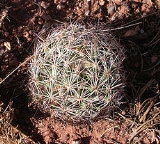
Escobaria vivipara
Encyclopedia
Escobaria vivipara is a species of cactus
known by several common names, including spinystar, and viviparous foxtail cactus. It is native to North America, where certain varieties can be found from Mexico to Canada. Most are limited to the Mojave
and Sonoran Desert
s. This is a small cactus growing to a maximum height of about 15 centimeters, often remaining smaller and oblong or spherical. It is densely covered in a mat of star-shaped arrays of straight white spines one to two and a half centimeters long. It flowers in yellow, pink, or purple blooms two to five centimeters across.
Varieties include:
era is known to have been a different one. From pollen core data, a portion of the prehistoric distribution of this species has been mapped; for example in the Late Wisconsin period, Escobaria vivipara occurred in the Waterman Mountains
(Coconino County) of northern Arizona
, (the Waterman Mountains
are in SE Arizona
), although the species does not occur in this location in the present time.
Cactus
A cactus is a member of the plant family Cactaceae. Their distinctive appearance is a result of adaptations to conserve water in dry and/or hot environments. In most species, the stem has evolved to become photosynthetic and succulent, while the leaves have evolved into spines...
known by several common names, including spinystar, and viviparous foxtail cactus. It is native to North America, where certain varieties can be found from Mexico to Canada. Most are limited to the Mojave
Mojave Desert
The Mojave Desert occupies a significant portion of southeastern California and smaller parts of central California, southern Nevada, southwestern Utah and northwestern Arizona, in the United States...
and Sonoran Desert
Sonoran Desert
The Sonoran Desert is a North American desert which straddles part of the United States-Mexico border and covers large parts of the U.S. states of Arizona and California and the northwest Mexican states of Sonora, Baja California, and Baja California Sur. It is one of the largest and hottest...
s. This is a small cactus growing to a maximum height of about 15 centimeters, often remaining smaller and oblong or spherical. It is densely covered in a mat of star-shaped arrays of straight white spines one to two and a half centimeters long. It flowers in yellow, pink, or purple blooms two to five centimeters across.
Varieties include:
- E. v. var. arizonica (Arizona spinystar) - native to the desert southwest of the United States
- E. v. var. bisbeeana (Bisbee spinystar) - native to ArizonaArizonaArizona ; is a state located in the southwestern region of the United States. It is also part of the western United States and the mountain west. The capital and largest city is Phoenix...
and New MexicoNew MexicoNew Mexico is a state located in the southwest and western regions of the United States. New Mexico is also usually considered one of the Mountain States. With a population density of 16 per square mile, New Mexico is the sixth-most sparsely inhabited U.S... - E. v. var. deserti (Desert spinystar) - found in the desert southwest
- E. v. var. kaibabensis (Kaibab spinystar) - mostly limited to Arizona
- E. v. var. neomexicana (New Mexico spinystar) - native to New Mexico and TexasTexasTexas is the second largest U.S. state by both area and population, and the largest state by area in the contiguous United States.The name, based on the Caddo word "Tejas" meaning "friends" or "allies", was applied by the Spanish to the Caddo themselves and to the region of their settlement in...
- E. v. var. vivipara - known as far north as ManitobaManitobaManitoba is a Canadian prairie province with an area of . The province has over 110,000 lakes and has a largely continental climate because of its flat topography. Agriculture, mostly concentrated in the fertile southern and western parts of the province, is vital to the province's economy; other...
Distribution
While the species presently has a broad range across the western part of North America, its distribution in the early HoloceneHolocene
The Holocene is a geological epoch which began at the end of the Pleistocene and continues to the present. The Holocene is part of the Quaternary period. Its name comes from the Greek words and , meaning "entirely recent"...
era is known to have been a different one. From pollen core data, a portion of the prehistoric distribution of this species has been mapped; for example in the Late Wisconsin period, Escobaria vivipara occurred in the Waterman Mountains
Waterman Mountains
The Waterman Mountains are a low mountainous landform in Pima County, United States. Numerous flora and fauna species are found in the Waterman Mountains, in the Pinyon-juniper woodland plant community. Notable among the tree species is the Elephant tree which species exhibits a contorted...
(Coconino County) of northern Arizona
Arizona
Arizona ; is a state located in the southwestern region of the United States. It is also part of the western United States and the mountain west. The capital and largest city is Phoenix...
, (the Waterman Mountains
Waterman Mountains
The Waterman Mountains are a low mountainous landform in Pima County, United States. Numerous flora and fauna species are found in the Waterman Mountains, in the Pinyon-juniper woodland plant community. Notable among the tree species is the Elephant tree which species exhibits a contorted...
are in SE Arizona
Arizona
Arizona ; is a state located in the southwestern region of the United States. It is also part of the western United States and the mountain west. The capital and largest city is Phoenix...
), although the species does not occur in this location in the present time.

